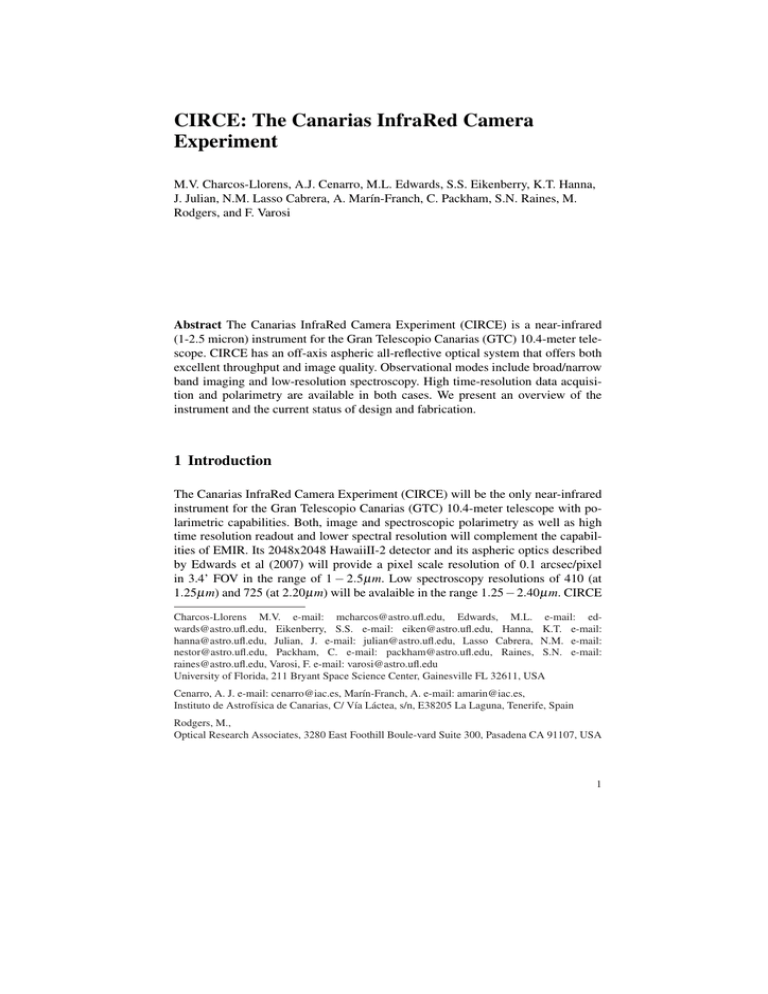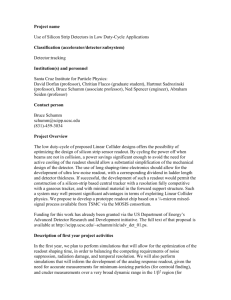CIRCE: The Canarias InfraRed Camera Experiment
advertisement

CIRCE: The Canarias InfraRed Camera Experiment M.V. Charcos-Llorens, A.J. Cenarro, M.L. Edwards, S.S. Eikenberry, K.T. Hanna, J. Julian, N.M. Lasso Cabrera, A. Marı́n-Franch, C. Packham, S.N. Raines, M. Rodgers, and F. Varosi Abstract The Canarias InfraRed Camera Experiment (CIRCE) is a near-infrared (1-2.5 micron) instrument for the Gran Telescopio Canarias (GTC) 10.4-meter telescope. CIRCE has an off-axis aspheric all-reflective optical system that offers both excellent throughput and image quality. Observational modes include broad/narrow band imaging and low-resolution spectroscopy. High time-resolution data acquisition and polarimetry are available in both cases. We present an overview of the instrument and the current status of design and fabrication. 1 Introduction The Canarias InfraRed Camera Experiment (CIRCE) will be the only near-infrared instrument for the Gran Telescopio Canarias (GTC) 10.4-meter telescope with polarimetric capabilities. Both, image and spectroscopic polarimetry as well as high time resolution readout and lower spectral resolution will complement the capabilities of EMIR. Its 2048x2048 HawaiiII-2 detector and its aspheric optics described by Edwards et al (2007) will provide a pixel scale resolution of 0.1 arcsec/pixel in 3.4’ FOV in the range of 1 − 2.5µ m. Low spectroscopy resolutions of 410 (at 1.25µ m) and 725 (at 2.20µ m) will be avalaible in the range 1.25 − 2.40µ m. CIRCE Charcos-Llorens M.V. e-mail: mcharcos@astro.ufl.edu, Edwards, M.L. e-mail: edwards@astro.ufl.edu, Eikenberry, S.S. e-mail: eiken@astro.ufl.edu, Hanna, K.T. e-mail: hanna@astro.ufl.edu, Julian, J. e-mail: julian@astro.ufl.edu, Lasso Cabrera, N.M. e-mail: nestor@astro.ufl.edu, Packham, C. e-mail: packham@astro.ufl.edu, Raines, S.N. e-mail: raines@astro.ufl.edu, Varosi, F. e-mail: varosi@astro.ufl.edu University of Florida, 211 Bryant Space Science Center, Gainesville FL 32611, USA Cenarro, A. J. e-mail: cenarro@iac.es, Marı́n-Franch, A. e-mail: amarin@iac.es, Instituto de Astrofı́sica de Canarias, C/ Vı́a Láctea, s/n, E38205 La Laguna, Tenerife, Spain Rodgers, M., Optical Research Associates, 3280 East Foothill Boule-vard Suite 300, Pasadena CA 91107, USA 1 2 Charcos-Llorens et al will reach the same depth than NIRC/Keck with slightly lower integration time and x25 greater FOV and 50% faster then NIRI/Gemini with 3 times greater FOV. This document summarizes the different parts of the instrument and describes the current status. Chapter 2 explains the optical layout. Chapter 3 is devoted to draw a picture of hardware and software systems. Chapter 4 gives the main ideas of the mechanical design. 2 Optical Design Observation modes include J,H,K image, low resolution spectroscopy, image polarimetry and spectropolarimetry. The optical design is optimized for image observation mode. The optical quality analysis [2] shows that images are seeing-limited and 80% of the energy is enclosed within 2 pixels (0.2”). Polarimetry in CIRCE consists on a half waveplate (HWP) and a MgF2 beam splitter fitted in this initial optical design. Polarimetry and standard modes can be selected during the observation. We follow the solution proposed by [5] using a Wedged Double-Wollaston (WeDoWo) that measures all linear STOKES parameters with a single exposure. Fast adquisition is important in observations of highly variables sources as microquasars. In practice, observation consists of two exposures with the HWP at angles 0◦ and 45◦ . In this configuration, we expect to obtain an accuracy of 0.15% in the measurement of Stokes parameters for SNR of 700:1. We use a filter box close to the pupil of the instrument and masks at the focal plane of the telescope in order to switch modes during the observation. The filter box contains five wheels. Three wheels are dedicated to broad-band (J, H, Ks) and narrow-band filters. The Lyot wheel at the pupil contains a stop for regular modes and a WeDoWo prism for polarimetric modes. The last wheel hold a low-resolution grism (R=410 @ 1.25um; R=725 @ 2.40 um) and a mid-Resolution grism (R=1500 @ J, H and K, for different diffraction orders). We use at the entrance of the instrument a focal plane mask and a decker mask. A translation stage inserts both masks when switching to spectroscopy or polarimetry modes. The focal plane mask includes a 0.4”, 0.7” and 1” long slits for regular spectroscopy. The same sizes of slits are also avalaible for spectropolarimetry. The mask includes three 12” slits for each width for spectropolarimetry. There are three 12x50” FOV slots for image polarimetry avoiding overlap of the extraordinary and ordinary images. The central slot/slit includes a HWP with a rotator mechanism for more accurate measurements of the linear polarization. In addition, high speed readout is available in image polarimetry at the central slot [1]. CIRCE: The Canarias InfraRed Camera Experiment 3 3 Hardware and Software Instrument mechanical subsystems are controlled through sensors and actuators, and all these mechanisms are controlled through the computer control system and the control software. CIRCE’s control hardware consists of four physical units: (1) the cryostat housing the detector array, optics and mechanisms, (2) the detector control hardware, (3) the mechanism control hardware, and (4) the Local Control Unit (LCU). The LCU is a Solaris/SPARC rack-mount computer that resides in the same rack as the mechanism control hardware. It is connected via TCP/IP over ethernet to a Perle console server, which provides serial RS-232 lines for commanding devices such as the mechanism control hardware. All motor indexers and monitoring devices are connected to the Perle and accept commands on a serial line. The detector control hardware, called Modular Camera Electronics (MCE), also accepts commands on a serial port connected to the Perle. The MCE performs the clocking and the readout of the detector array (Hawaii-2 2Kx2K 1.0-2.5 m), the A/D conversion and the coadding of frames. Once the data acquisition is done, the LCU receives detector frames from the MCE via a fiberoptic link using the EDT PCI framegrabber. Reducing the effective size of the detector increases the speed of frame capture in our instrument. This trend in the design of instruments will allow to time-solve highly variable objects. Table 1 shows a comparison between the expected readout times for the HAWAII-2 with different frame sizes versus the readout time of the 2048x2048 HAWAII-2 32 outputs array. Reductions to 23% and 13% are expected when using frame sizes of 512x512 and 256x256 respectively [3]. Software of the control system is composed of device agents for mechanism and detector control. The device agents are software components based on UFLib classes using UFProtocol messages over TCP/IP sockets. Each device agent is a single threaded process that handles client socket connections. The device agents are MCE3 agent, motor control agent, LS-218 temperature monitor agent, LS-340 temperature control agent, pressure monitor agent and the frame grabber agent. The latter copies frames from the EDT PCI framegrabber into process heap memory. Then the frame acquisition server (FAS) collects all the header information from the MCE3 agent and the telescope and writes FITS files into the local data archive. Software has been developed and tested and the electronic design is at final stage [4] 4 Mechanics The bench is under cryogenic temperatures and support the 8 mirrors, the detector, the filter wheel box and the focal plane mechanisms. The general picture of the bench is a flat rectangular plate with a structure to support the liquid nitrogen can in the bottom without perturbations of the flatness by the gas pressure. We use a unique and specialized solution to align optical mirror surfaces that consist in testing the entire optics as a unique system during the polishing process. This novel 4 Charcos-Llorens et al technique encompasses the design of the bench, bracket, and mirrors because it requires immediate correction of alignment problems in situ and defining perfectly all the elements in the bench before start polishing mirrors. Although this delays the beginning of manufacturing until the design is totally defined the step of aligment and testing is considerably faster. Blank mirrors and brackets are presently made. The optical bench is in manufacturing process and the whole system is close to be ready to start assembling phase. Table 1 Comparison between the expected readout times for the HAWAII-2 with different frame sizes versus the readout time of the 2048x2048 HAWAII-2 32 outputs array. Detector Type HAWAII-2 output) HAWAII-2 output) HAWAII-2 output) HAWAII-2 output) Frame Size (pixels) Readout Time Example Time (seconds) vs. 2048x2048 HAWAII-2 Readout Time (32 2048x2048 100% 1.5 (32 1024x1024 50% 0.75 (32 512x512 26% 0.39 (32 256x256 13% 0.195 References 1. Miguel V. Charcos-Llorens, Stephen S. Eikenberry, Michelle L. Edwards, Nestor M. Lasso Cabrera, Antonio Marin-Franch, Christopher C. Packham, Proceedings of the SPIE, [7014-91 2008] 2. M. L. Edwards, S. S. Eikenberry, A.Marin-Franch, M. Rodgers, J. Julian, and K. Hanna1; 2005 RevMexAA (Serie de Conferencias), 24, 235-236 3. Nestor M. Lasso Cabrera, Kevin T. Hanna, Stephen S. Eikenberry, Michelle L. Edwards, Miguel V. Charcos-Llorens, Antonio Marin-Franch , Proceedings of the SPIE, [7014-92 2008] 4. Marn-Franch, Antonio Eikenberry, Stephen S. Charcos-Llorens, Miguel V. Edwards, Michelle L. Varosi, Frank Hon, David B. Raines, Steven N. Warner, Craig D. Rashkin, David Proceedings of the SPIE, Volume 6269, pp. 62694V (2006). 5. Oliva, E.; 1997 A&A Suppl. Ser. 123, 589-592
